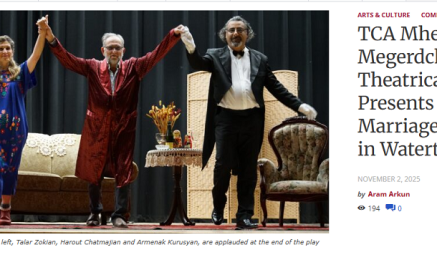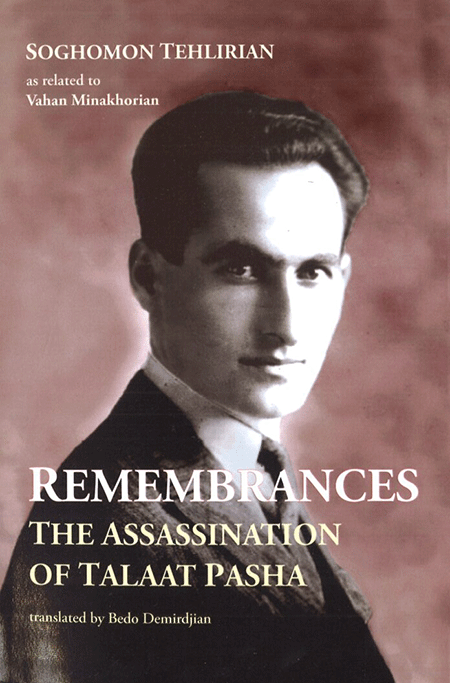The Armenian Mirror-Spectator. DETROIT AND BOSTON — Brian Ansbigian, 32, is an oud player born and raised in the Boston area, who has been up-and-coming for some time now. He is regarded by elders as well as his peers as one of the newest major players in this style of music among Armenians. He has studied under Udi John Berberian and often performs with Leon Janikian (clarinet), Joe Kouyoumjian (oud), and many other New England musicians including his father David Ansbigian (guitar and oud). He is a member of St. James Armenian Church, the Armenian General Benevolent Union (AGBU), and National Association for Armenian Studies and Research (NAASR). He is an alum of the Armenian Church Youth Organization of America.
What is your background and how did you get interested in music, and Armenian music and the oud in particular?
It’s in my blood, and I think that’s actually pretty common among us Armenian musicians. I am a fourth-generation Armenian-American musician. My father learned Armenian folk music from his grandfather, and I learned from him. Some of my earliest memories as a child are of my father sitting in our living room playing his oud along with his Armenian records and tapes. I developed a love and appreciation not only for the music, but also for the instrument itself. I was about 15 or 16 when I started to seriously study the oud, and haven’t looked back since. In addition to playing, I’ve become a “collector” of sorts of the instruments themselves, and I’m especially interested in acquiring antique ouds by Armenian makers. I have always thought of a well-made oud as a work of art.
Talk a little about your father and great-grandfather and their music, what about other family members?
Read also
My great-grandfather, Harry Belezarian, immigrated to Worcester from Kharpert in 1913. He was among the first wave of Armenian immigrants to bring our music to America. Like many of his peers, he didn’t have any formal musical training, and played primarily “kef” music — folk and dance music with origins in Western Armenia. Luckily, he had the foresight to record himself often, and even went on to create multiple LPs as a vocalist with the Mesrob Takakjian Orchestra in Fresno, CA. I’m fortunate to have those recordings today, and you could say that they formed the basis for my father’s, and later my own, interest in the music. It was Harry and his son Harry Jr. who encouraged my father to start playing the oud when he was just a kid – in fact, they provided him with his very first oud (which he still has, by the way). My father did the same for me.
Tell us about your relationship with Oudi John Berberian.
John is a mentor, teacher and friend. Imagine for a moment that you are a young guitar player, and someone offers you the opportunity to study one-on-one with Eric Clapton — one of the greatest guitar players in the world. That’s what it’s like to study oud with John. I don’t think anyone has inspired me or influenced my playing more than he has, and until I began studying with him formally, I had been mostly self-taught. John sort of took me under his wing and helped refine my technique and the way I approach music. I’ve learned so much from him – from theory and technique to countless songs.
What inspires you to play. Where do the emotions come from and how does that come across in your playing?
Inspiration comes from many sources. I love Armenian culture and history, and music is a medium through which I can actively contribute to it. The oud, because it is fretless, provides the artist with almost limitless opportunity for self-expression. I have a deep appreciation for “traditional” ways of interpreting our music, but I like to push boundaries with my playing and I’m constantly working to develop my own personal sound. I’m always iterating and playing around with the way I do things.
What are some of the interesting gigs you have played at, and who are some of the other musicians you have played with and have a relationship with?
Last year I was honored to play at the opening of NAASR’s new Vartan Gregorian building in Belmont. I also enjoy playing with artists outside of the Armenian sphere; last year I played with a Greek ensemble at a Greek Music Festival.
What do you believe is the importance of the style of music you play in relation to the Armenian community and culture?
Anyone who studies and plays a traditional instrument like the oud, kanun, duduk, etc. plays a crucial role in sharing and preserving our music. Roughly 50 percent of the music I play originated in Western Armenia prior to the Genocide and expulsion of Armenians from Anatolia, and I believe there is a great deal of historical value in learning and playing it. I think Armenian folk music in all forms — whether it’s traditional music of the Armenian highlands, the compositions of Sayat Nova or our unique American flavor of “kef” music — is in danger of dying out in the diaspora. A large portion of this music is not notated and it only survives is if each generation passes it to the next. The same is true of the skill and knowledge required to play a folk instrument. As a community, I think we need to do a better job of cultivating an interest in this music, specifically within the younger generations. We also need to bring our traditional instruments to the forefront and create more outlets for exposure to them. An electronic keyboard with a “kanun” tone is not a traditional instrument.
What are some of your favorite songs or albums?
There are too many to list. Many of the late 19th century classical compositions by Tatyos Ekserciyan are my favorite pieces to play, and I’m very fond of Khachatur Avetisyan’s compositions as well.
What is so great about the oud?
It’s literally ancient, and has managed to survive for thousands of years virtually unchanged. Today, it has a ubiquitous presence across the Middle East, but the way it is played is quite different depending on where you are. Each country and ethnic group has its own distinctive sound. I certainly like to branch out and discover other artists from different backgrounds — whether Greek, Turkish, Syrian, etc.
The oud has been a part of Armenian culture for hundreds of years, and I think it deserves a lot more attention within the Armenian community – beyond something that just shows up at a church festival or dance. It is far too historic and versatile to be relegated to those venues only.
As a community, I think we’ve become a bit too obsessed with making sure everything is “purely” Armenian. The oud is ubiquitous across the Middle East. It is certainly not “purely” Armenian, but Armenians have played it for hundreds of years. The instrument itself is built and played like it is today specifically because of the contributions Armenian musicians and luthiers made, and continue to make.
Harry Kezelian




























































